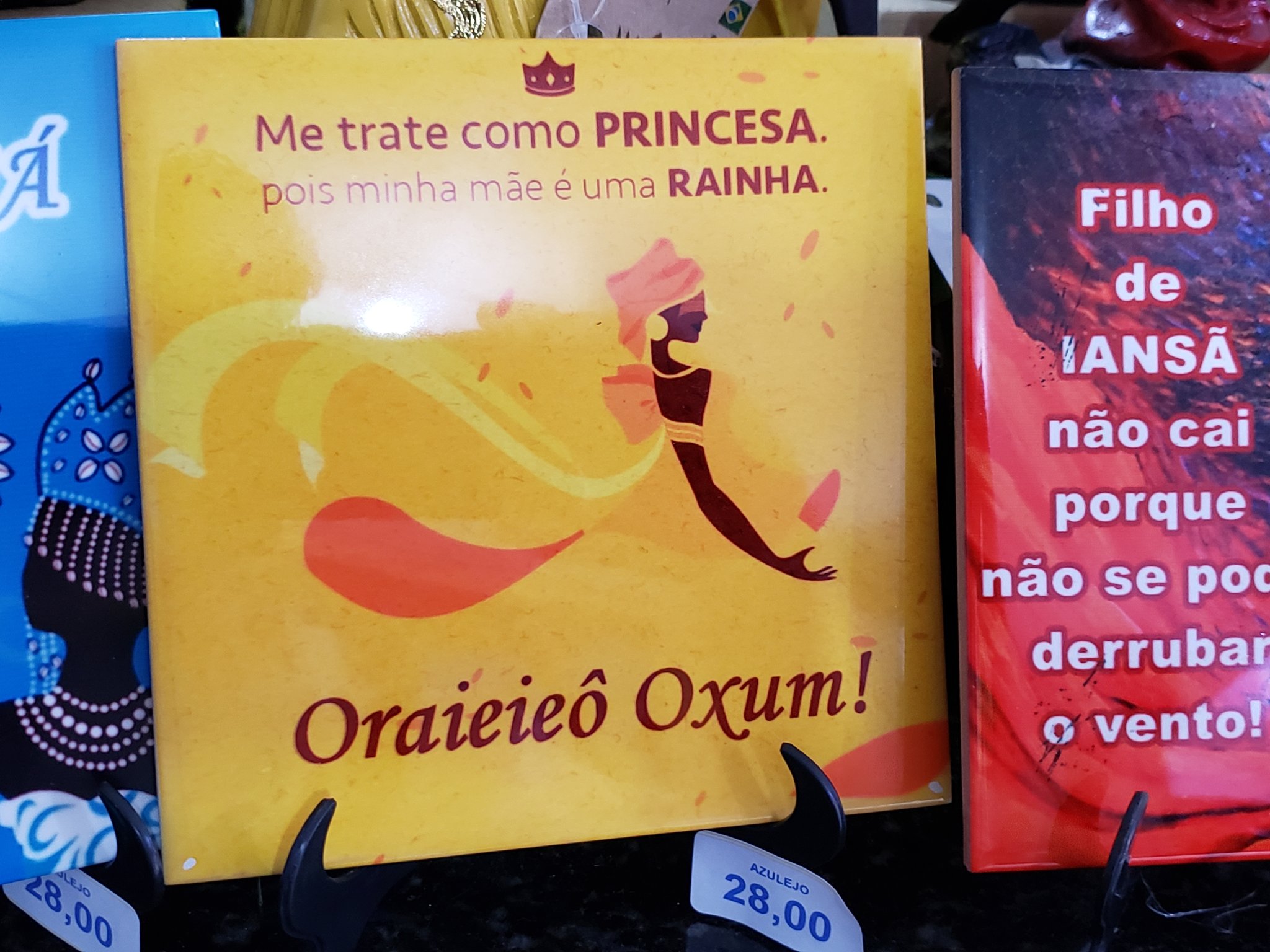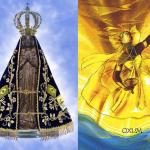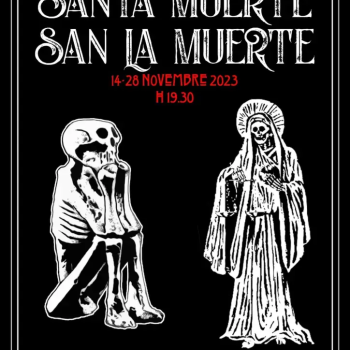
Co-authored by Dr. Kate Kingsbury* and Dr. Andrew Chesnut
In a country with the world’s second largest Black population, it’s no surprise that many of the most popular religious figures in Brazil are conceived of as African or derived from Africa. For example, the Orixás or gods the Afro-Brazilian religion of Candomblé are of Yoruban lineage presided over by Yemanja, the goddess of the sea. Likewise, one of the three major types of spirit guides in the less Afrocentric religion of Umbanda are the Pretos Velhos, old Black slaves known for their healing powers and wise counsel. And even in the largest Catholic church on the planet, the star is a Black Madonna, the Virgin of Aparecida, patroness of Brazil who as we will detail has been syncretised with the orixá of love, beauty, female power, magic and fertility: Oxum, also known as Oshun.
Because the Orixás and spirit guides of Candomblé and Umbanda have provided a spiritual alternative to the Catholic saints, folk saints such as the Mexican ones, Santa Muerte and Jesus Malverde, have not been as important in Brazil as in most of Hispano-America. Just as the great majority of the advocations of Mary in Europe are as a white European woman, the two premier representations of the Virgin in the Americas, black Aparecida and brown-complected Guadalupe, reflect the demographics of Afro-Brazil and mestizo Mexico. Like the vast majority of Black Madonnas of Europe and the New World, Aparecida wasn’t created as an Afro-Brazilian advocation. Rather, she was originally a white representation of the Virgin of the Immaculate Conception who darkened after years of being lost in the river Paraiba. Many of the other Black Madonnas were similarly blackened by the elements, most often fire, candle smoke, and dirt.
Though not created as an African Madonna, Our Lady of Aparecida was eventually embraced by the Church in Brazil, which had invested precious little in the evangelisation of African slaves. In fact, during much of colonial era the largest corporate slaveholder were the Jesuits who denied the humanity of Africans while defending the rights of Indigenous peoples. Prior to the appearance of Aparecida, Africans in Brazil generally continued to worship their own deities camouflaged from persecution by association with the Catholic saints, such as the Orixá, Omulú, the god of healing and disease, with Lazarus.

However with the advent of Aparecida and her eventual elevation to the status of national patroness, Afro-Brazilians now not only had a few African Catholic saints, such as Ifigenia, that resembled them but also the very Mother of God, made in their own Black image. And it’s precisely this connection with Afro-Brazilian devotees that distinguishes Aparecida from most of the other Black Madonnas, such as the Our Lady of Częstochowa, whose devotees are predominantly white and mestizo. Reinforcing her Afro-Brazilian identity is her spiritual symbiosis with the Orixá, Oxum, also known as Oshun. Oxum is associated with female strength, love, beauty, fertility, pregnancy, and magic.
When the Portuguese colonised Brazil their Old World diseases, together with their use of brute force, caused the genocide of most of the Indigenous peoples, yet they needed people to work their sugar plantations and gold mines. They therefore turned to Africa for slave labour. Many of those captured and taken away on boats to work for the Portuguese were from West Africa, especially Nigeria and Benin, where Orixás were venerated. Those who came brought with them their traditions which altered, as over time these were syncretised with Portuguese Catholic traditions.
Candomblé and Umbanda developed when the Portuguese converted the slaves to Catholicism under duress and outlawed African religions. In a bid to preserve their own spiritual traditions, the slaves related the Catholic saints to their own African spirits, called Orixás, through a syncretic process, thus Yemanjá the spirit of the sea and mother of all Orixás was identified by slaves with the Virgin Mary. Likewise Oxalá, the Lord of the Sky, was equated with Jesus and the two were seen as one and the same deity.
Orixás are believed by the Yoruba to be deified ancestors who, when extant, presided over the forces of nature such as the wind, the water or thunder, as well as specific activities such as magic, hunting, or knowledge of the qualities and uses of plants. After the death of the Orixá-ancestor, their power could be transmitted momentarily to one of their descendants, or initiated devotees might embody and take on these powers during trances whereby they became possessed by them. In Brazil, such trances and possessions remain a central element to Candomblé and Umbanda.
In the process of syncretism that took place in Brazil, Oxum was related to Aparecida, whose name means ‘appeared’ because she emerged from the waters of the river. Oxum is said to be the Orixá of fresh waters. Her realm is that of so-called ‘sweet’, gentle waters such as lakes, waterfalls and rivers, hence their connection, as Aparecida emerged from a river. They are also similar as both as described as compassionate, strong maternal figures who protect and honour children. Worship of Oxum is usually carried out near aquatic bodies and in places of nature.
In Yoruba mythology, from whence Oxum derives, it is stated that the goddess was brought into existence by Olodumare, the Supreme Creator. After creating the earth, he realised that there was a void, something was missing: sweetness and love. Ancient Yoruba legends state that humankind would not exist if Oxum had not been sent to our world for her sweet and fertile waters brought life back to humanity. Oxum is said to be the most feminine of all the Orixás, yet despite her delicacy and sensitivity she is also deemed to be powerful and capable of great magic. She is the goddess who devotees are said to be able to turn to when others have proved ineffectual, as she is described as an efficient and potent miracle worker. She is the wife of Xangô, the god of lightning and thunder.
Within rituals dedicated to her, water plays a pivotal role as a cleansing and renewing element. Initiates generally seek to wet their bodies, either dousing themselves with water or immersing themselves entirely in bodies of water, and offerings are usually left by the water’s edge or even cast into the water, The imagery of water, cleansing and rebirth is contiguous also with the fluids contained by the amniotic sac, thus Oxum is believed to be responsible for breaking women’s water during child labour.

As a sensuous, fecund goddess Oxum is also said to be the deity of love, passion and eroticism. She is associated with the planet Venus and even sometimes with the Greek Goddess of love, thus turned to by initiates for matters of the heart. Oxum is also depicted as a goddess of magic and is known as the Queen of Witches. Devotees attest that she loves casting spells, especially those related to romance and seduction.
Love spells, wherein initiates ask for the goddess’ help, with matters of the heart usually feature yellow candles, cinnamon or sandalwood oil, rose petals, and oblations of sunflowers, oranges, pumpkin water and honey. The goddess is associated with the sweetness of honey. This is why the nectar is affirmed to be her favourite offering. As will be outlined, yellow is one of the main colours in her iconography and thus yellow flowers and food items, as well as seafood are given to the goddess as oblations.
Oxum’s mythology also attributes to her the role of Lady of Gold, and according to devotees she presides over financial matters, distributing wealth and abundance to those who serve her. In Africa, Oxum was associated with copper as this was the most precious metal of ancient times, and thus this still remains one of Oxum’s favorite oblations, offered to her along with honey and fine perfume at altars dedicated to her by her worshippers. However, during the 18th century, the Portuguese discovered that Brazil was mineral rich and a gold rush ensued. Many slaves had to work the mines. From this time onward, gold became of major importance not only to the Portuguese but also to those who laboured forcibly for them. Oxum in keeping with the zeitgeist thus became associated with the metal.

Sometimes copper or gold coins or objects may be cast by initiates into bodies of water as ex-votos to Oxum. In keeping with this, yellow or gold, alongside white are said to be her colours, hence icons depicting her always feature the deity garbed in flowing robes of such colours. As Lady of Gold, she is also said to have a fondness for luxury and the finer things in life, thus her demands for fine, sweet perfume. The desire for such lavish items by devotees as oblations to their goddess should not be seen as a dream of luxury but rather a memory and mimicry of the excesses of the colonialists whose opulent lifestyles came at the expense of the backbreaking toil of slave labour.
Oxum is a complex multi-faceted goddess, portrayed as extremely sensitive and characterised by woeful weeping, loneliness and longing for love. Those who take on her persona in trance may therefore become lachrymose and inconsolable. Nevertheless, Oxum does not embody a simplistic portrayal of weak, effete female sensitivity, as in Christian traditions wherein Marian advocations are meek, mild and virginal. In keeping with her African origins and subsaharan formulations of gender, where Yoruba women across West Africa in pre-colonial times might occupy roles of great economic, supernatural or political puissance and even assert their sexuality, Oxum is also deemed to be powerful, a dangerous foe and even a femme fatale.
Oxum does not only give life to those who seek children, she may also dish out death and destruction. She is capable, it is believed, of bringing misfortune to those who cross her as she has a penchant for vengeance and may turn against those who do not honour her. Her ire is evinced in the Nigerian legends of Osogobo where Oshun is credited with victory over the invading Fulani Muslim Jihadists who sought to take local lands from the Yoruba. The Fulani camped outside, near the home of Oxum, ready to defeat the remaining Oyo soldiers who had hidden in the surrounding towns and villages of Osogobo.
The Fulani however were defeated by Oxum who was vexed by their invasion of her home. She shape-shifted into a food merchant and sold poisoned vegetables to the invaders. The Fulani developed dysentery and diarrhea from the toxic produce and thus were easily ousted by the Yoruba warriors. This had tremendous repercussions for the Yoruba as it halted the jihadists’ territorial expansion into South Western Nigeria. For the Yoruba, Oxum is thus related to sacred kingship and the safeguard of royalty, as she protected the nobles of Osogobo from attackers. In Brazil, although she has largely lost this association, the understanding of her as a powerful matriarch remains and this links her to Aparecida who is said to have been so strong as to withstand and emerge from the powerful currents of the river Paraiba to suffuse the world, like Oxum, with love and compassion.
*Dr. Kate Kingsbury obtained her doctorate in anthropology at the University of Oxford, where she also did her Mphil. Dr. Kingsbury is a polyglot fluent in English, French, Spanish. She is a polymath interested in exploring the intersections between anthropology, religious studies, philosophy, sociology and critical theory. Dr. Kingsbury is Adjunct Professor at the University of Alberta, Canada. She is fascinated by religious phenomena, not only in terms of their continuity across the Holocene and into the Anthropocene but equally interested in the changes wrought to praxis and belief by humans ensuring the infinite esemplasticity that is inherent to all religions, allowing for their inception, survival, alteration, regeneration and expansion across time and space. Dr. Kingsbury is a staunch believer in equal rights and the power of education to ameliorate global disparities. She also works pro bono for a non profit organisation that aims to empower and educate girls in Uganda. Follow Dr. Kingsbury on Twitter


















